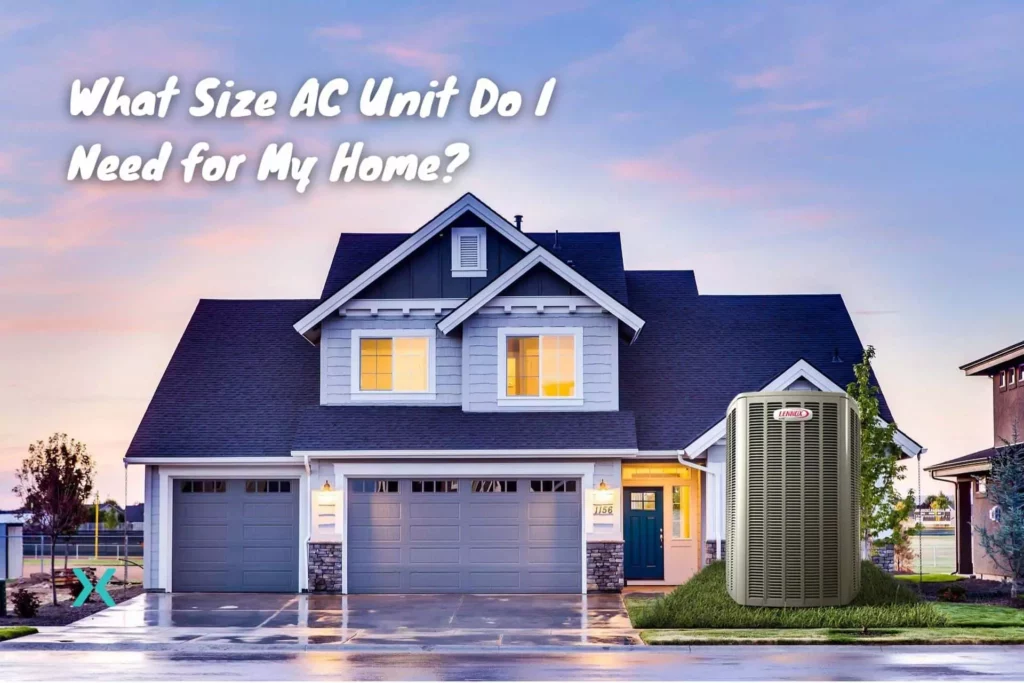What Size AC Unit Do I Need for My Home?
We’re often asked, “what size AC unit do I need for my house?“
First, of course, plenty of factors affect the proper size of your AC unit, such as the which you’re your home faces, the height of your ceilings, and the thickness and type of your insulation.
It should come as no surprise that with most of these questions, HVAC technicians have a tendency to rant about technicalities like load calculations and R-values. At Phyxter Home Services, we’re usually no different…
But what do terms like “tonnage” and “residential load calculation” actually mean?
Many have told me that I, too, need to speak in more easy-to-understand terms and stop going off on technical tangents when I talk about these things.
So, hopefully, to your benefit, in this article, we will explain how to correctly determine what particular air conditioner you need for your home in layman’s terms.
We’ll do it in two sections.
✋ First, we will take a quick peek at how to get a general idea of what size HVAC system is right for your home.
✋Second, we will go more in-depth about properly using load calculations to identify your home’s proper air conditioner sizing.
Table of Contents
⭐ Part I: A Short, Layman’s Guide to What Size AC Unit to Buy for Your House
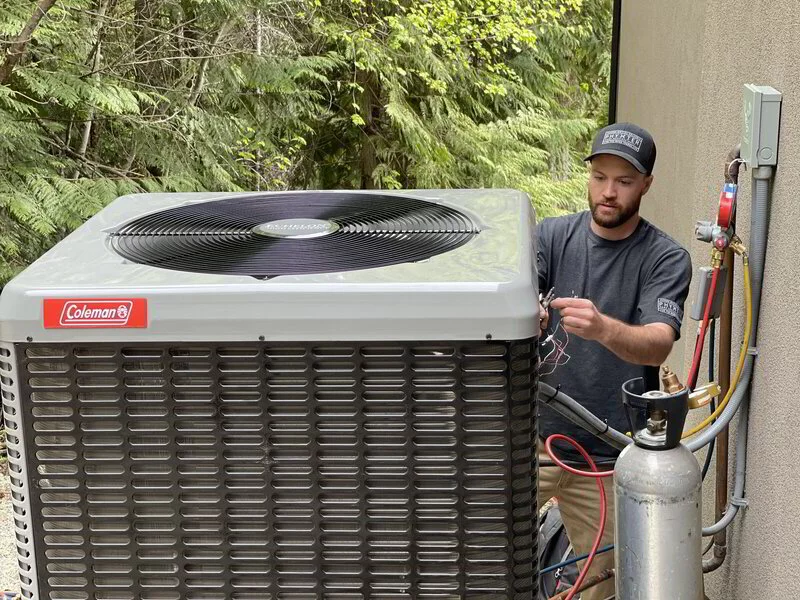
This part addresses three ways to calculate a home’s appropriately sized unit without getting into the nitty-gritty.
It is for the general homeowner who isn’t familiar with air conditioners or how they work.
The first two ways are rule-of-thumb and give you a decent ballpark of what size AC you should be looking at.
The last way in this section uses automated software to calculate a more precise AC size and does all the work.
But first, let’s talk about some important terms you should know.
What Different Sizes Does Your Central AC Come In?
So there are a few different ways to get a good idea of what sized AC unit you’ll need.
Two methods are relatively close to getting a ballpark AC size estimate, and the third is the most precise.
This is done with an automated software program.
So before figuring out what sized AC is suitable for your house, you’ll need to check what sizes you can purchase (keep in mind, this blog article refers to your AC size, not the type of AC).
For more information on different AC types, see Ductless Air Conditioning and Heat Pumps.
Air Conditioners are manufactured in various sizes, and the size they are measured in is called “tonnage.”
Contrary to what you might think, the tonnage of an air conditioning unit is not actually based on its weight. Instead, a “ton” measures an AC’s ability to cool.
1 ton is the ability of your AC to cool 12,000 BTUs (British Thermal Units) in 1 hour.
Likewise, a “2-ton” central AC can cool 24,000 BTUs per hour.
So now you probably asking, what is a BTU? British Thermal Unit is a measurement of the energy required to heat or cool 1 pound of fresh water by one degree Fahrenheit.
Another way to look at this is how much heat can the unit remove in one hour.
So a 1-ton AC can cool 12,000 pounds of water by one degree every hour.
That’s all it means, so don’t let your HVAC contractor tell you differently!
The central AC installed in your home will range from 1.5-ton to 5-ton units and increase in half-ton increments (2-ton, 2.5-ton, 3-ton, etc.).
However, anything over 5 tons is generally considered a light commercial HVAC unit (not available for residential projects).
Therefore, if your house requires an AC unit of this size, you’ll need to install multiple AC units.
If your home needs 6 tons of cooling capacity, you’d need two 3-ton units installed (instead of a single 6-ton unit).
This may seem overkill, but the nice part about two systems running together is that you still have one unit running if one fails completely.
This might not keep your house at a comfortable 68°F (20°C), but it can at least keep your home from skyrocketing into the 90s (32°C) in the middle of summer.
Unless you have a huge mansion or zero insulation in your home, you are unlikely to need anything more than a 5-ton unit.
Why Does the Right Sized AC Matter So Much?
We are going to say it: size matters.
However, I will skip the obvious joke at the risk of alienating half of my readers.
It is a common misconception that bigger is better.
Conventional wisdom is wrong in thinking that a 3-ton unit would work well, then a 4-ton central AC unit must perform much better.
This mistaken idea was based on considerable older central air conditioners from the 1980s, which used a ton of energy and could cool the Mall of America in less than 15 minutes.
Remember back then, electricity was cheap, and insulation was relatively unheard of if installed at all.
These days, energy efficiency is the name of the environmental game, and modern central air conditioners run in cooling cycles, slowly but steadily lowering the temperature of your house instead of doing it rapidly.
❌ If Your AC is Too Big
If you buy a central AC that is too big for your house, it will run more like that AC unit from the 1980s – it will turn on quickly, cool your home rapidly and then shut down.
Your house will still be cool and comfortable.
But due to it not going through the entire cooling cycle it was designed for, heat will soon infiltrate your home and have to turn on again.
First, it will rapidly cool your house and then turn off again.
This constant on-off cycle will defeat the purpose of its energy-efficient design and drive up your electricity bill.
Rapid cycling also doesn’t give your AC time to remove the humidity from the indoor air.
This means you will have a cold and damp house with a unit too large for its purpose.
❌ If Your AC is Too Small
If your AC is too small, it will constantly run and spend most of the day trying to get to where it should be.
But, your house will still be nice and cool (unless it’s several sizes too small).
The problem is that modern central ACs, unlike your AC from the 80s, will have a hard time cooling your entire home if it’s too small.
This is because they are made to work slowly over time and don’t have the power to cool your house rapidly.
As a result, they will run constantly and again up your electric bill.
✅ If Your AC is Sized Just Right
A properly sized central AC will run through the required cooling cycles to keep your house comfortable. Still, it will not run so much that it loses its efficiency.
Next, we will get into some sizing calculations, so get your nerd hat on, and get ready to do some 4th-grade long division (or just use the calculator on your phone).
⭐ How to Calculate the Right Sized AC for Your House

Now that you know what sizes your AC comes in, you can figure out how to calculate the right-sized central AC unit for your house.
There are two different ways to get a ballpark size estimate for your home and one more precise way in this section.
👨💻 Method 1: Use the “Old-School” Equation:
So for instance, a 1,500 square foot home would look something like this:
1,500 square footage X 30 = 45,000
45,000 / 12,000 = 3.75
3.75 – 1.0 = 2.75. You’d need a 2.5 or 3-ton central air conditioning unit.
NOTE: This is for an average North American home, however, and will be undersized for hot, arid climates like the Southwest. Instead of subtracting 1.0, subtract ZERO to get the appropriate AC size for hot and arid climates:
1,500 square footage X 30 = 45,000
45,000 / 12,000 = 3.75
3.75 – (0.0) = 3.75, You’d need a 3.5 or 4-ton central air conditioning unit in hot and arid climates (southern California, Arizona, etc.).
👨💻 Method 2: Calculate Central AC Size Using an AC Sizing Graph:
The second way to find out what size AC you might need for your home is to use the chart below.
Unfortunately, it is not nearly as accurate as the equation above (because it’s been around for decades).
Still, if you’re looking for a quick ballpark value, then this is worth a reference because it also takes into account the average temperatures in your region.
For instance, the required size of an AC system in Salt Lake City, Utah, differs significantly from the one you’d need in our service area of the Okanagan Valley in British Columbia.
Start at the bottom of the graph by finding your area on the map of the continental US and note what color you are (Alaska uses blue, Hawaii uses orange).
Then go to the top and find your zone color.
Next, go down your zone until you find the total square footage of your house, and note the required size on the left.
This is an age-old tool based on national averages.
It gets an essential point across regarding how size varies with temperature regions, but remember that you aren’t building an air conditioning system for “average” temperatures.
You are usually building them for high temperatures, precisely where you live; the point still remains.
As you can see, the appropriately sized AC for a 1,900 square foot home in SLC is quite different from the required size in Seattle, WA.
Hopefully, this section helped you get a quick idea of what size AC is right for your home.
But keep in mind that this is just a ballpark estimate.
There are several factors that this doesn’t account for, such as how much shade you have, what kind of insulation you have, average temperature increases over the last few decades, and how high your ceilings are.
You’ll need to keep reading and look at our next section to account for this.
If used, the AC units from this graph would be undersized in Zone 1, hot and arid climates.
I would add a ton to the above results to estimate what size air conditioner you would need in these regions. Again… it’s an estimate.
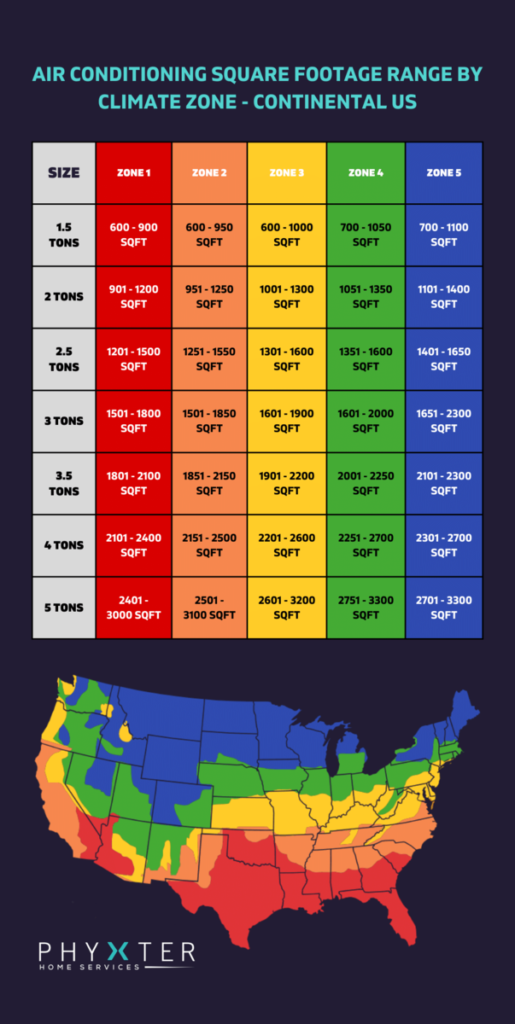
👨💻 Method 3: Calculate the Ideal Sized Air Conditioner & Furnace for Your House:
Look, you don’t want to overpay for an extra-large AC unit if you don’t need it, right?
On the other hand, you might end up paying $800 more than you need to.
And you certainly don’t want an undersized one.
So, in our humble opinion, it’s best to leave this to the professionals when using Manual J and D calculation software.
This type of automated software considers the various factors that affect the heat load on your home.
It works by entering information about your specific home, your project, and the area in which you live.
The program will then use conditional logic to ask you additional questions it needs to give you the most accurate information, such as:
- How hot does it get in your area during the summer?
- How about the winter?
- How much shade is usually on your house?
- Do you have a basement or a slab?
- What color is your roof?
….and so on…
When calculating the best-sized air conditioner for your home, questions like these must be asked.
If the HVAC tech or Energy auditor knows what they are doing, you will get a recommended size and efficiency range for an AC suitable to your home.
⭐ Part II: What Size Central AC Do I Need for My Home? The In-Depth Guide
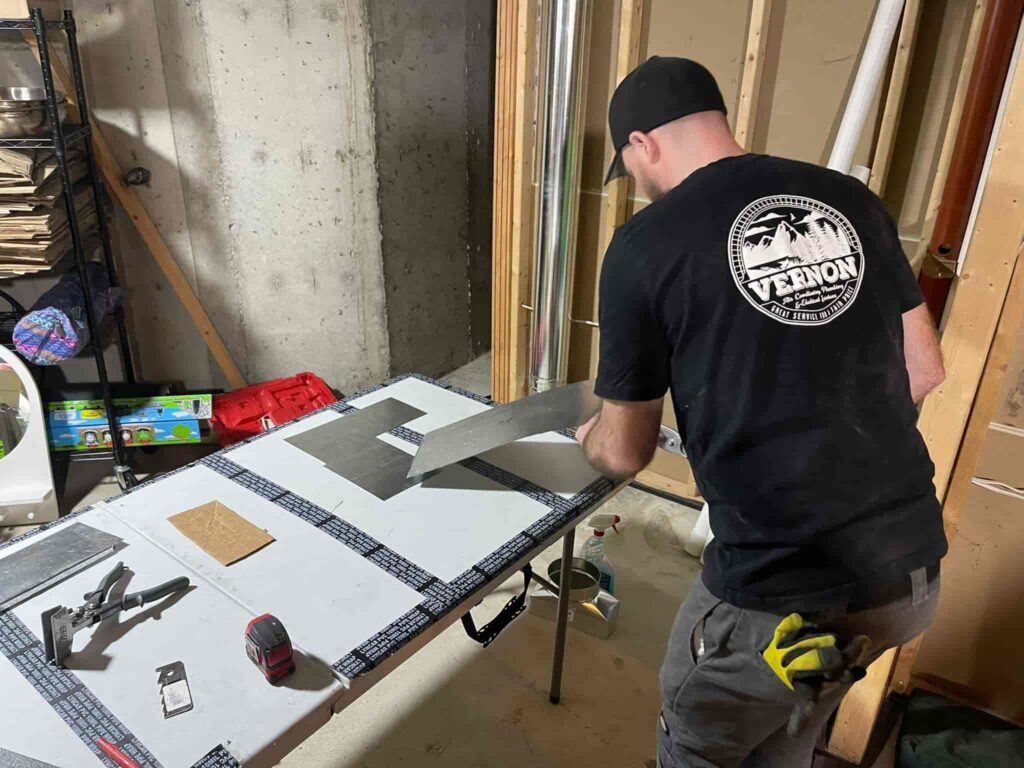
If you disregarded my advice and skipped straight to this section on what size central air conditioner to buy for your home.
But if you still don’t have that much experience with central air conditioners, or if this is all new to you, then I’d recommend that you scroll up and read Part I first.
✅ Introduction to the “Manual-J” – The Proper Way to Calculate the Right Size Air Conditioner.
If you are here to see the real deal on how your HVAC contractor should be computing an adequately sized central air conditioner for your house, then prepare to nerd out!
The proper way to calculate the required size for your central air conditioner is by running a load calculation known in the HVAC industry as a “Manual-J.” (For more information on what the word HVAC means, check out: What Does HVAC Mean?)
A Manual-J calculation is a detailed analysis of your home’s central air conditioning and heating needs.
There are two types of manual-J calculations: a whole house load calculation and a room-by-room load calculation.
✅ Whole House Load Calculation vs. Room by Room Load Calculation.
A whole house load calculation, or a “block calculation,” is a Manual-J used to determine the amount of cooling required for an entire house as a whole and takes into account:
- Heat transfer between walls
- Number of windows and their efficiency rating
- Type of insulation and how much of it
- Heat transfer through your concrete slab
- Number of people in your house (each person gives off around 250 BTUs per hour)
- How many sky-lights you have
- Amount of lighting you have and what type
- Type of ducting and the ducting location (in your attic or inside your home’s insulation)
- A few other factors.
A Manual-J calculation of a room-by-room load calculation is used to calculate all of the above inputs. It is done for each room and then added together as a whole.
Generally, a room-by-room load calculation is the best way to get an accurate idea of what size central air conditioner is best for your house, but each method is useful for different things.
Related Reading: HVAC Duct Calculator
✅ When to use a House Load Calc and when to use a Room by Room Load Calculation.
When to use each is less a matter of science and more a matter of art.
In general, a whole house calculation is best used if your HVAC contractor is only replacing your AC unit but not your ducting, having already determined that the current ducting in your home is sufficient.
Be careful – many HVAC contractors would just assume to replace your central air conditioning unit and not mess with the ducting.
Still, the modern way of ducting a home is much more involved than the old way, which was basically to run a tube to each room and call it good.
For a contractor, replacing the central AC unit and skipping the ducting is easier because the money is mainly spent installing the HVAC unit and requires the least time.
Ducting is a hassle and takes a decent amount of time, during which the contractor is paying his crew $25-$50 an hour.
A room-by-room calculation is best if the central air conditioner and the ducting need to be replaced.
If it isn’t done correctly, there is just too much energy (and therefore cash) lost in ducting, so ensure you get a good contractor and do it right.
There isn’t a lot of money in it, but it is essential to do the job right.
Imagine you have a room with large windows on the sunny side of your house. This room will heat up far more quickly than a room on the dark side of the house with no windows, right?
The sunny room will probably need extra ducting. In addition, another register (an AC vent) will be added to ensure it is adequately cooled.
If you have enough rooms like this, you will probably need a larger system—just something to keep in mind.
✅ Which Should You Use to Calculate the Proper Size AC for Your Home?
I know that you aren’t going to like this answer.
Still, you will need to buy some software for a Manual-J calculation.
However, I wouldn’t recommend getting that in-depth unless you are an HVAC contractor.
Remember that you are paying your contractor to come to your house and do a Manual-J calculation for you!
However, if you are absolutely determined to do it yourself, you can purchase a pretty good Manual-J product here: ACCA Approved Software for Manual J and D Calculations.
✅ Manual-J Software
Otherwise, I would recommend two things:
First, if you are going to do it yourself, start small and start with a house load calculation; and second, don’t try and tackle a complete, comprehensive Manual-J by yourself. It is not an intelligence thing.
It’s an experience thing, so don’t let your ego get the better of you!
You can mess up many things in one of these calculations (I know because I’ve done it myself), which could lead to you buying the wrong sized central air conditioner for your house.
⭐ Some Additional Tips for Sizing Your AC
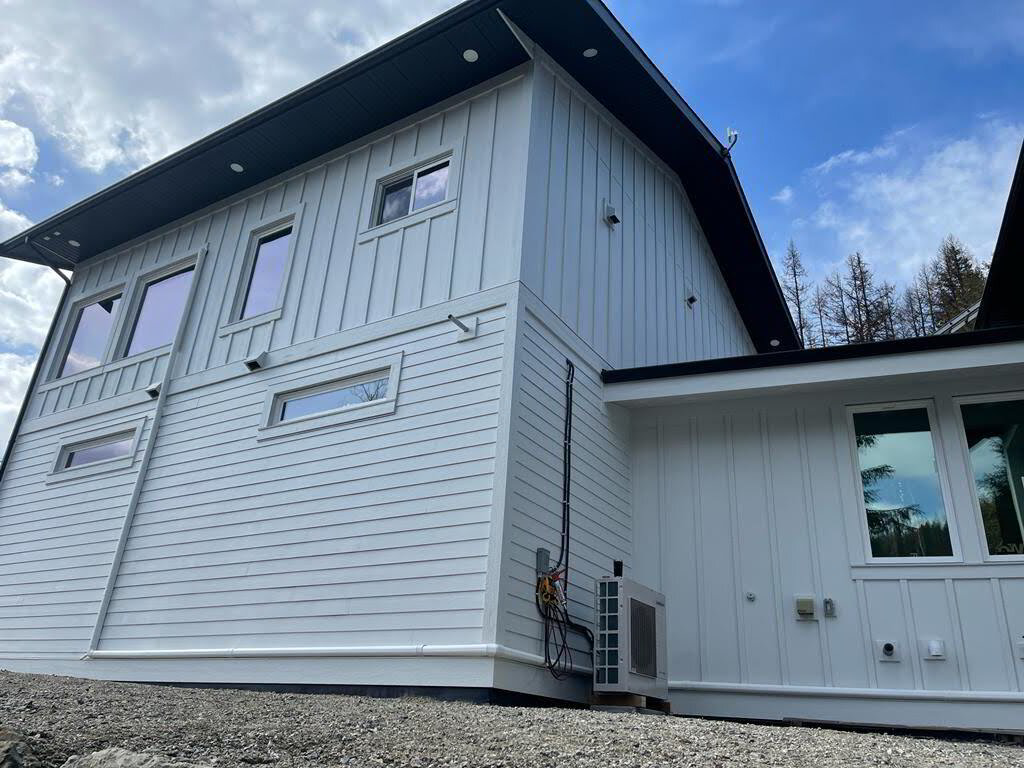
1. Make your HVAC contractor do a Manual J Calculation
Remember, no HVAC contractor, no matter how experienced, can look at your home and say what size central air conditioner is best for your house.
The better ones who have been doing this long enough can give you an answer after asking you some questions about your insulation and sticking their head into your attic, but be wary of anyone who looks at your house and says, “yea, you’re gonna be a 3-ton unit.”
It doesn’t work that way. Just because the old unit was 3-ton doesn’t mean the new one will be!
2. Get Multiple Estimates
If you are not in North or Central Okanagan, here is a good article on choosing an HVAC contractor. Don’t skimp on your contractor – it will cost you more in the long run!
3. Consider Replacing your Ductwork
Consider replacing your ductwork, too, unless it’s in good shape. Improper ducting is like having a solid heart with clogged arteries – the system still doesn’t work.
Hotter rooms should have multiple ducts and registers.
4. Size Matters
There is a such thing as too big of an air conditioner, as well as too small.
5. Choose Your HVAC Contractor Wisely
Who you get to install your central air conditioner is more important than which air conditioner you buy or what size it is.
See item 2 above for tips on how to choose a reputable contractor.
6. Check the SEER Values of your AC
Once you are done with figuring out what size air conditioner is right for your house, take a look at SEER (Seasonal Energy Efficiency Ratio) values, too – here’s a good place to start: What is a Good SEER Rating?
7. Make AC Maintenance a Priority
Don’t forget to take care of your new AC: Air Conditioner Maintenance Plan.
8. Brand Choice
Once you have figured out who should install your AC and what size central air conditioner to buy, you should start looking at brands.
Not all air conditioners are the same, so do your research.
⭐ Final Thoughts on What Size AC to Buy

I hope you have found this article on what size central air conditioner to buy for your house somewhat helpful.
For more answers to questions like this, visit the Phyxter home improvement blog.
If you live in North or Central Okanagan, give us a call.
We can set you up with the perfect energy-efficient unit that’s affordable and reliable for your home and budget, professionally installed by the best HVAC technicians on the market.

